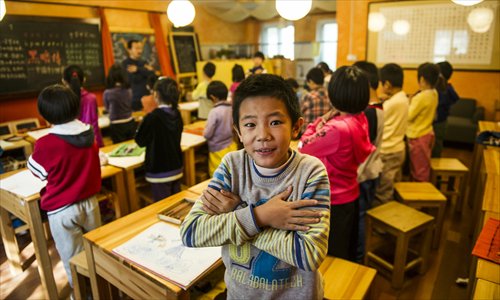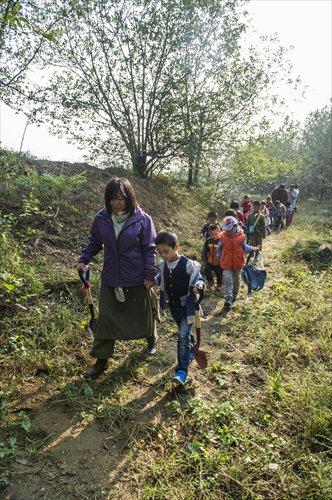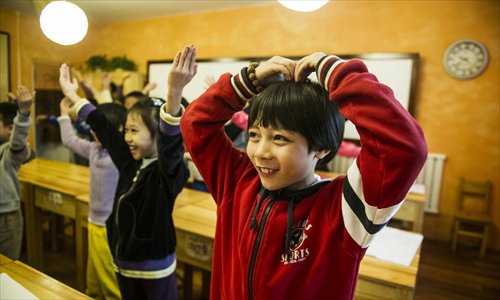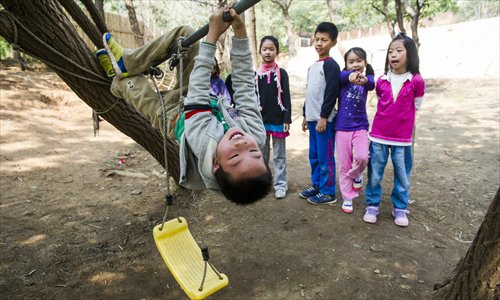An alternative education
A radically humanistic approach to pedagogy is gaining a following in China

A third-grader in a Spring Valley Waldorf School classroom. Photo: Li Hao/GT

Preschool students at the school on their way to an organic farm not far from the school grounds. Photo: Li Hao/GT
The first thing that one notices upon entering a classroom at the Spring Valley Waldorf School is that there are no textbooks.
There are no long multiplication tables, or standardized learning diagrams pinned to any of the powdery pink walls. The only materials that record what has been taught are made by students themselves, in large robust scrapbooks.
There are no set curriculums. No standardized tests. No grades. Just groups of contented children, gently guided along by a teacher, to sing, dance, paint, mould, sculpt, dig, weave, build, knit, plant, play, and learn.
Tucked away in the mountains on the outskirts of Beijing's Haidian district, the school is one of more than 300 preschools and elementary schools following a radically alternative approach to education known as the Waldorf method.
Developed by Austrian philosopher and educator Rudolf Steiner in the first two decades of the 20th century, the Waldorf approach emphasizes the role of imagination in learning.
Lessons, particularly at the preschool and early elementary levels, are primarily hands-on and sensory-based.
Rather than memorizing times tables by rote, multiplication is learned through games which require students to perform certain actions with their bodies on multiples of a particular number. Rather than simply reading about folk stories, students are asked to perform them in classroom theatrical productions. Rather than copying diagrams about photosynthesis, students are taken into the hills to dig up the earth, and plant seeds.
The goal, according to Waldorf educators, is to cultivate a love of learning, and to develop free-thinking, morally responsible and socially engaged individuals.

Students at the school contort themselves into different poses as part of an exercise for learning pinyin. Photo: Li Hao/GT

Students monkey around in the playground at the Spring Valley Waldorf School. Photo: Li Hao/GT
In search of an alternative
"I grew up under the traditional education system and I didn't want my daughter to follow the same path. Chasing after the highest grades and cramming information by rote won't help her in her later life," said Xu Ping, 42, who enrolled her daughter at the Spring Valley Waldorf School last April.
Prior to enrolling at the school, Xu's daughter attended a kindergarten that followed the Montessori educational approach, which likewise emphasized exploratory, hands-on learning that gives students a large amount of freedom. But as the kindergarten did not offer elementary education, Xu decided to enroll her daughter at the Spring Valley Waldorf School.
"Many parents think that Waldorf education is still at the experimental stage in China, and do not want to risk to sending their children there," said Xu.
"But I didn't want my daughter to simply be an obedient child, as she would have been taught to be in a traditional school. I want her to grow into an adult with a strong will and a clear understanding of the world."
"Waldorf education has a long history in Western countries. After learning about it through a series of workshops, I believed it was suitable for her," said Xu.
Transferring to the school was not a simple process. Located more than two hours' drive from the center of Beijing, Xu had to make the difficult decision to relocate the family somewhere closer.
As part of the school's admissions policy, Xu also had to agree to being interviewed by a panel of the school's administrators, to ensure that she understood and agreed with the school's teaching philosophies. The school requires parents to be intimately involved in their child's education, and periodically runs workshops for parents and their children.
"When new students first arrive, it sometimes takes them a while to let go of their old habits of simply being obedient and passive," said Yu Ningyuan, director of the Spring Valley Waldorf School. "But later, they start to relax and will feel a sense of relief."
Founded in 2011, the school currently has around 100 students from preschool through to elementary school grade four. The classrooms are divided into two rows of idyllic red-brick buildings, with ample wooden verandahs. The school grounds also include an organic farm, where students learn basic agricultural skills.
"Every day, the children can hear birds singing and insects chirping. During recesses, they can play in the sand and the dirt. They breathe along with nature," said Wang Shoumao, a teacher of the fourth-grade class at the school.
"[We've] strived to cultivate a natural environment for the children, so it's a little bit like having a rural education."
According to Yu, most of the teachers at the school are certified by approved Waldorf education training centers: Wang received his master's degree in Waldorf pedagogy from Freie Hochschule Stuttgart (Waldorf Teachers College) in Germany; and Yu has more than a decade of experience teaching at Waldorf schools in the US. However, the school is not on the Waldorf World List 2014, a directory of certified schools published by the official international Waldorf sanctioning body.
Integrated learning
One of the unique features of Waldorf education is that subjects are taught in a way that is integrated, rather than as separate fields of knowledge with disparate concerns. Instead of dividing learning units into discrete subjects like history or mathematics, each subject will be integrated through a common topic, said Yu.
For example, if the topic is "architecture," students will be instructed to approach it from multiple disciplines, from mathematics (measurement and geometry), to history (how houses have changed over time), to literacy (a myth or fairy tale about houses). These topics are taught in blocks of several weeks at a time, and are called "main lessons."
"For the math component [of this main lesson], I teach them about measurement, as part of building a house. Afterwards, the children build their own model houses, which is great fun for them," Wang added.
For each main lesson topic, a hands-on approach is adopted. "For example, [one of the main lesson topics] is farming. So our students make their own biodynamic farm," said Yu.
Yu added that teacher acts as a role model and a guide, rather than strictly as an authority figure, and collaboration is encouraged over competition. Learning outcomes are evaluated through portfolio work, personal reports, and discussions between teachers, parents and students, rather than through exams or competitive grades.
Looking towards the future
According to the Waldorf World List 2014, there are currently 1,039 certified Waldorf schools around the world.
"Since the first Waldorf school was established in Germany in 1919, Waldorf education has become one of the largest independent alternative education movements in the world," said Huang Xiaoxing, who co-founded China's first Waldorf school in Chengdu, Sichuan Province in 2004.
Huang identified three main obstacles impeding Waldorf's growth in China. The first was the lack of qualified Waldorf teachers in the country, and the second was the lack of government support. Finally, said Huang, Waldorf schools still lack legitimacy in China. Of the over 300 Waldorf schools that Huang estimates are in China, only six are certified on the Waldorf World List 2014.
With the concern that unqualified education staff will influence the development of Waldorf education in China, Huang and other Waldorf educators are taking steps to tackle the challenges. In lieu of official accreditation, and to promote wider acceptance for Waldorf education in China, Huang is hosting a series of workshops and classes for parents and teachers to maintain the standards of Waldorf education in the country.
This March, the Spring Valley Waldorf School partnered with the University of Modern Administration in Beijing to found Spring Valley College, an institution that will train teachers in the Waldorf system.
In addition, Spring Valley Waldorf School, which is affiliated with the Beijing Bowen School in Fangshan district to allow it to operate legally as a school under China's laws, hopes to expand beyond simply being an elementary school in coming years.
"In the future, students will be able to take the gaokao (the national college entrance examinations) or other exams to be admitted entry into higher education," said Yu.
"In this way, students can apply for both the universities home and abroad."
But Chu Zhaohui, professor at the National Institute of Education Sciences, advised parents to be cautious about sending their children to Waldorf schools if they want their children to enter a first-class university.
"Students graduating from Waldorf schools will find it very hard to get admitted into a top university in China because students can not transfer from such way of education to exam-oriented education in a short time," said Chu. "However, some children who are suited to the Waldorf approach will be able to nurture their talents and realize their worth after they enter society."
"People should be tolerant of diverse ways of education rather than only traditional routes. Waldorf education is one of many approaches, which might yield results for certain students," Chu said.